- Home
- Robert Graves
The Greek Myths
The Greek Myths Read online
PENGUIN BOOKS
THE GREEK MYTHS
VOLUME ONE
Robert Graves was born in 1895 in Wimbledon, son of Alfred Percival Graves, the Irish writer, and Amalia Von Ranke. He went from school to the First World War, where he became a captain in the Royal Welch Fusiliers. His principal calling was poetry, and his Selected Poems have been published in Penguin Twentieth-Century Classics. Apart from a year as Professor of English Literature at Cairo University in 1926 he earned his living by writing, mostly historical novels, which include I, Claudius; Claudius the God; Sergeant Lamb of the Ninth; Count Belisarius; Wife to Mr Milton; Proceed, Sergeant Lamb; The Golden Fleece; They Hanged My Saintly Billy; and The Isles of Unwisdom. He wrote his autobiography, Goodbye to All That, in 1929 and it rapidly established itself as a modern classic. The Times Literary Supplement acclaimed it as ‘one of the most candid self-portraits of a poet, warts and all, ever painted’, as well as being of exceptional value as a war document. His two most discussed non-fiction books are The White Goddess, which presents a new view of the poetic impulse, and The Nazarine Gospel Restored (with Joshua Podro), a re-examination of primitive Christianity. He translated Apuleius, Lucan, and Suetonius for the Penguin Classics series, and compiled the first modern dictionary of Greek Mythology, The Greek Myths. His translation of The Rubáiyát of Omar Khayyám (with Omar Ali-Shah) is also published in Penguin. He was elected Professor of Poetry at Oxford in 1961, and made an Honorary Fellow of St John’s College, Oxford, in 1971.
Robert Graves died on 7 December 1985 in Majorca, his home since 1929. On his death The Times wrote of him, ‘He will be remembered for his achievements as a prose stylist, historical novelist and memorist, but above all as the great paradigm of the dedicated poet, “the greatest love poet in English since Donne”.’
ROBERT GRAVES
THE GREEK MYTHS
VOLUME ONE
PENGUIN BOOKS
PENGUIN BOOKS
Published by the Penguin Group
Penguin Books Ltd, 80 Strand, London WC2R 0RL, England
Penguin Putnam Inc., 375 Hudson Street, New York, New York 10014, USA
Penguin Books Australia Ltd, 250 Camberwell Road, Camberwell, Victoria 3124, Australia
Penguin Books Canada Ltd, 10 Alcorn Avenue, Toronto, Ontario, Canada M4V 3B2
Penguin Books India (P) Ltd, 11 Community Centre, Panchsheel Park, New Delhi – 110 017, India
Penguin Books (NZ) Ltd, Cnr Rosedale and Airborne Roads, Albany, Auckland, New Zealand
Penguin Books (South Africa) (Pty) Ltd, 24 Sturdee Avenue, Rosebank 2196, South Africa
Penguin Books Ltd, Registered Offices: 80 Strand, London WC2R 0RL, England
www.penguin.com
First published 1955
Reprinted with amendments 1957
Revised edition 1960
25
Copyright © Robert Graves, 1955, 1960
All rights reserved
Except in the United States of America, this book is sold subject to the condition that it shall not, by way of trade or otherwise, be lent, re-sold, hired out, or otherwise circulated without the publisher’s prior consent in any form of binding or cover other than that in which it is published and without a similar condition including this condition being imposed on the subsequent purchaser
ISBN: 978-0-14-195965-8
CONTENTS OF VOLUME ONE
FOREWORD
INTRODUCTION
1. THE PELASGIAN CREATION MYTH
2. THE HOMERIC AND ORPHIC CREATION MYTHS
3. THE OLYMPIAN CREATION MYTH
4. TWO PHILOSOPHICAL CREATION MYTHS
5. THE FIVE AGES OF MAN
6. THE CASTRATION OF URANUS
7. THE DETHRONEMENT OF CRONUS
8. THE BIRTH OF ATHENE
9. ZEUS AND METIS
10. THE FATES
11. THE BIRTH OF APHRODITE
12. HERA AND HER CHILDREN
13. ZEUS AND HERA
14. BIRTHS OF HERMES, APOLLO, ARTEMIS, AND DIONYSUS
15. THE BIRTH OF EROS
16. POSEIDON’S NATURE AND DEEDS
17. HERMES’S NATURE AND DEEDS
18. APHRODITE’S NATURE AND DEEDS
19. ARES’S NATURE AND DEEDS
20. HESTIA’S NATURE AND DEEDS
21. APOLLO’S NATURE AND DEEDS
22. ARTEMIS’S NATURE AND DEEDS
23. HEPHAESTUS’S NATURE AND DEEDS
24. DEMETER’S NATURE AND DEEDS
25. ATHENE’S NATURE AND DEEDS
26. PAN’S NATURE AND DEEDS
27. DIONYSUS’S NATURE AND DEEDS
28. ORPHEUS
29. GANYMEDES
30. ZAGREUS
31. THE GODS OF THE UNDERWORLD
32. TYCHE AND NEMESIS
33. THE CHILDREN OF THE SEA
34. THE CHILDREN OF ECHIDNE
35. THE GIANTS’ REVOLT
36. TYPHON
37. THE ALOEIDS
38. DEUCALION’S FLOOD
39. ATLAS AND PROMETHEUS
40. EOS
41. ORION
42. HELIUS
43. THE SONS OF HELLEN
44. ION
45. ALCYONE AND CEYX
46. TEREUS
47. ERECHTHEUS AND EUMOLPUS
48. BOREAS
49. ALOPE
50. ASCLEPIUS
51. THE ORACLES
52. THE ALPHABET
53. THE DACTYLS
54. THE TELCHINES
55. THE EMPUSAE
56. IO
57. PHORONEUS
58. EUROPE AND CADMUS
59. CADMUS AND HARMONIA
60. BELUS AND THE DANAIDS
61. LAMIA
62. LEDA
63. IXION
64. ENDYMION
65. PYGMALION AND GALATEA
66. AEACUS
67. SISYPHUS
68. SALMONEUS AND TYRO
69. ALCESTIS
70. ATHAMAS
71. THE MARES OF GLAUCUS
72. MELAMPUS
73. PERSEUS
74. THE RIVAL TWINS
75. BELLEROPHON
76. ANTIOPE
77. NIOBE
78. CAENIS AND CAENEUS
79. ERIGONE
80. THE CALYDONIAN BOAR
81. TELAMON AND PELEUS
82. ARISTAEUS
83. MIDAS
84. CLEOBIS AND BITON
85. NARCISSUS
86. PHYLLIS AND CARYA
87. ARION
88. MINOS AND HIS BROTHERS
89. THE LOVES OF MINOS
90. THE CHILDREN OF PASIPHAË
91. SCYLLA AND NISUS
92. DAEDALUS AND TALOS
93. CATREUS AND ALTHAEMENES
94. THE SONS OF PANDION
95. THE BIRTH OF THESEUS
96. THE LABOURS OF THESEUS
97. THESEUS AND MEDEA
98. THESEUS IN CRETE
99. THE FEDERALIZATION OF ATTICA
100. THESEUS AND THE AMAZONS
101. PHAEDRA AND HIPPOLYTUS
102. LAPITHS AND CENTAURS
103. THESEUS IN TARTARUS
104. THE DEATH OF THESEUS
MAP OF THE GREEK WORLD
A complete index to both volumes and a map showing the sites mentioned in the text will be found at the end of Volume 2
The death of the Old Bull of the Year apparently poleaxed, and the birth of the New Year’s Bull-Calf from a date cluster; under the supervision of a Cretan priestess, who identifies herself with the palm-tree. From a Middle-Minoan bead-seal in the author’s collection (diameter enlarged 1½ times). About 1900 B.C.
FOREWORD
SINCE revising The Greek Myths in 1958, I have had second thoughts abou
t the drunken god Dionysus, about the Centaurs with their contradictory reputation for wisdom and misdemeanour, and about the nature of divine ambrosia and nectar. These subjects are closely related, because the Centaurs worshipped Dionysus, whose wild autumnal feast was called ‘the Ambrosia’. I no longer believe that when his Maenads ran raging around the countryside, tearing animals or children in pieces (see 27.f) and boasted afterwards of travelling to India and back (see 27. c), they had intoxicated themselves solely on wine or ivy-ale (see 27. 3). The evidence, summarized in my What Food the Centaurs Ate (Steps: Cassell & Co., 1958, pp. 319–343), suggests that Satyrs (goat-totem tribesmen), Centaurs (horse-totem tribesmen), and their Maenad womenfolk, used these brews to wash down mouthfuls of a far stronger drug: namely a raw mushroom, amanita muscaria, which induces hallucinations, senseless rioting, prophetic sight, erotic energy, and remarkable muscular strength. Some hours of this ecstasy are followed by complete inertia; a phenomenon that would account for the story of how Lycurgus, armed only with an ox-goad, routed Dionysus’s drunken army of Maenads and Satyrs after its victorious return from India (see 27. e).
On an Etruscan mirror the amanita muscaria is engraved at Ixion’s feet; he was a Thessalian hero who feasted on ambrosia among the gods (see 63. b). Several myths (see 102, 126, etc.) are consistent with my theory that his descendants, the Centaurs, ate this mushroom; and, according to some historians, it was later employed by the Norse ‘berserks’ to give them reckless power in battle. I now believe that ‘ambrosia’ and ‘nectar’ were intoxicant mushrooms: certainly the amanita muscaria; but perhaps others, too, especially a small, slender dung-mushroom named panaeolus papilionaceus, which induces harmless and most enjoyable hallucinations. A mushroom not unlike it appears on an Attic vase between the hooves of Nessus the Centaur. The ‘gods’ for whom, in the myths, ambrosia and nectar were reserved, will have been sacred queens and kings of the pre-Classical era. King Tantalus’s crime (see 108. c) was that he broke the taboo by inviting commoners to share his ambrosia.
Sacred queenships and kingships lapsed in Greece; ambrosia then became, it seems, the secret element of the Eleusinian, Orphic and other Mysteries associated with Dionysus. At all events, the participants swore to keep silence about what they ate or drank, saw unforgettable visions, and were promised immortality. The ‘ambrosia’ awarded to winners of the Olympic footrace when victory no longer conferred the sacred kingship on them was clearly a substitute: a mixture of foods the initial letters of which, as I show in What Food the Centaurs Ate, spelled out the Greek word ‘mushroom’. Recipes quoted by Classical authors for nectar, and for cecyon, the mint-flavoured drink taken by Demeter at Eleusis, likewise spell out ‘mushroom’.
I have myself eaten the hallucigenic mushroom, psilocybe, a divine ambrosia in immemorial use among the Masatec Indians of Oaxaca Province, Mexico; heard the priestess invoke Tlaloc, the Mushroom-god, and seen transcendental visions. Thus I wholeheartedly agree with R. Gordon Wasson, the American discoverer of this ancient rite, that European ideas of heaven and hell may well have derived from similar mysteries. Tlaloc was engendered by lightning; so was Dionysus (see 14. c); and in Greek folklore, as in Masatec, so are all mushrooms – proverbially called ‘food of the gods’ in both languages. Tlaloc wore a serpent-crown; so did Dionysus (see 27. a). Tlaloc had an underwater retreat; so had Dionysus (see 27. e). The Maenads’ savage custom of tearing off their victims’ heads (see 27. f and 28. d) may refer allegorically to tearing off the sacred mushroom’s head – since in Mexico its stalk is never eaten. We read that Perseus, a sacred King of Argos, converted to Dionysus worship (see 27. i), named Mycenae after a toadstool which he found growing on the site, and which gave forth a stream of water (see 73. r). Tlaloc’s emblem was a toad; so was that of Argos; and from the mouth of Tlaloc’s toad in the Tepentitla fresco issues a stream of water. Yet at what epoch were the European and Central American cultures in contact?
These theories call for further research, and I have therefore not incorporated my findings in the text of the present edition. Any expert help in solving the problem would be greatly appreciated.
R. G.
Deyá, Majorca,
Spain, 1960.
INTRODUCTION
THE medieval emissaries of the Catholic Church brought to Great Britain, in addition to the whole corpus of sacred history, a Continental university system based on the Greek and Latin Classics. Such native legends as those of King Arthur, Guy of Warwick, Robin Hood, the Blue Hag of Leicester, and King Lear were considered suitable enough for the masses, yet by early Tudor times the clergy and the educated classes were referring far more frequently to the myths in Ovid, Virgil, and the grammar school summaries of the Trojan War. Though official English literature of the sixteenth to the nineteenth centuries cannot, therefore, be properly understood except in the light of Greek mythology, the Classics have lately lost so much ground in schools and universities that an educated person is now no longer expected to know (for instance) who Deucalion, Pelops, Daedalus, Oenone, Laocoön, or Antigone may have been. Current knowledge of these myths is mostly derived from such fairy-story versions as Kingsley’s Heroes and Hawthorne’s Tanglewood Tales; and at first sight this does not seem to matter much, because for the last two thousand years it has been the fashion to dismiss the myths as bizarre and chimerical fancies, a charming legacy from the childhood of the Greek intelligence, which the Church naturally depreciates in order to emphasize the greater spiritual importance of the Bible. Yet it is difficult to overestimate their value in the study of early European history, religion, and sociology.
‘Chimerical’ is an adjectival form of the noun chimaera, meaning ‘she-goat’. Four thousand years ago the Chimaera can have seemed no more bizarre than any religious, heraldic, or commercial emblem does today. She was a formal composite beast with (as Homer records) a lion’s head, a goat’s body, and a serpent’s tail. A Chimaera has been found carved on the walls of a Hittite temple at Carchemish and, like such other composite beasts as the Sphinx and the Unicorn, will originally have been a calendar symbol: each component represented a season of the Queen of Heaven’s sacred year – as, according to Diodorus Siculus, the three strings of her tortoise-shell lyre also did. This ancient three-season year is discussed by Nilsson in his Primitive Time Reckoning (1920).
Only a small part, however, of the huge, disorganized corpus of Greek mythology, which contains importations from Crete, Egypt, Palestine, Phrygia, Babylonia, and elsewhere, can properly be classified with the Chimaera as true myth. True myth may be defined as the reduction to narrative shorthand of ritual mime performed on public festivals, and in many cases recorded pictorially on temple walls, vases, seals, bowls, mirrors, chests, shields, tapestries, and the like. The Chimaera and her fellow calendar-beasts must have figured prominently in these dramatic performances which, with their iconographic and oral records, became the prime authority, or charter, for the religious institutions of each tribe, clan, or city. Their subjects were archaic magic-makings that promoted the fertility or stability of a sacred queendom, or kingdom – queendoms having, it seems, preceded kingdoms throughout the Greek-speaking area – and amendments to these, introduced as circumstances required. Lucian’s essay On the Dance lists an imposing number of ritual mimes still performed in the second century A.D.; and Pausanias’s description of the temple paintings at Delphi and the carvings on Cypselus’s Chest, suggests that an immense amount of miscellaneous mythological records, of which no trace now remains, survived into the same period.
True myth must be distinguished from:
(1) Philosophical allegory, as in Hesiod’s cosmogony.
(2) ‘Aetiological’ explanation of myths no longer understood, as in Admetus’s yoking of a lion and a boar to his chariot.
(3) Satire or parody, as in Silenus’s account of Atlantis.
(4) Sentimental fable, as in the story of Narcissus and Echo.
(5) Embroidered history, as in Arion’s adventure with the dolph
in.
(6) Minstrel romance, as in the story of Cephalus and Procris.
(7) Political propaganda, as in Theseus’s Federalization of Attica.
(8) Moral legend, as in the story of Eriphyle’s necklace.
(9) Humorous anecdote, as in the bedroom farce of Heracles, Omphale, and Pan.
(10) Theatrical melodrama, as in the story of Thestor and his daughters.
(11) Heroic saga, as in the main argument of the Iliad.
(12) Realistic fiction, as in Odysseus’s visit to the Phaeacians.1
Yet genuine mythic elements may be found embedded in the least promising stories, and the fullest or most illuminating version of a given myth is seldom supplied by any one author; nor, when searching for its original form, should one assume that the more ancient the written source, the more authoritative it must be. Often, for instance, the playful Alexandrian Callimachus, or the frivolous Augustan Ovid, or the dry-as-dust late-Byzantine Tzetzes, gives an obviously earlier version of a myth than do Hesiod or the Greek tragedians; and the thirteenth-century Excidium Troiae is, in parts, mythically sounder than the Iliad. When making prose sense of a mythological or pseudo-mythological narrative, one should always pay careful attention to the names, tribal origin, and fates of the characters concerned; and then restore it to the form of dramatic ritual, whereupon its incidental elements will sometimes suggest an analogy with another myth which has been given a wholly different anecdotal twist, and shed light on both.
A study of Greek mythology should begin with a consideration of what political and religious systems existed in Europe before the arrival of Aryan invaders from the distant North and East. The whole of neolithic Europe, to judge from surviving artifacts and myths, had a remarkably homogeneous system of religious ideas, based on worship of the many-titled Mother-goddess, who was also known in Syria and Libya.
Ancient Europe had no gods. The Great Goddess was regarded as immortal, changeless, and omnipotent; and the concept of fatherhood had not been introduced into religious thought. She took lovers, but for pleasure, not to provide her children with a father. Men feared, adored, and obeyed the matriarch; the hearth which she tended in a cave or hut being their earliest social centre, and motherhood their prime mystery. Thus the first victim of a Greek public sacrifice was always offered to Hestia of the Hearth. The goddess’s white aniconic image, perhaps her most widespread emblem, which appears at Delphi as the omphalos, or navel-boss, may originally have represented the raised white mound of tightly-packed ash, enclosing live charcoal, which is the easiest means of preserving fire without smoke. Later, it became pictorially identified with the lime-whitened mound under which the harvest corn-doll was hidden, to be removed sprouting in the spring; and with the mound of sea-shells, or quartz, or white marble, underneath which dead kings were buried. Not only the moon, but (to judge from Hemera of Greece and Grainne of Ireland) the sun, were the goddess’s celestial symbols. In earlier Greek myth, however, the sun yields precedence to the moon – which inspires the greater superstitious fear, does not grow dimmer as the year wanes, and is credited with the power to grant or deny water to the fields.

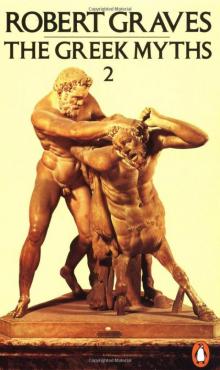 The Greek Myths, Volume2
The Greek Myths, Volume2 The Anger of Achilles: Homer's Iliad
The Anger of Achilles: Homer's Iliad Count Belisarius
Count Belisarius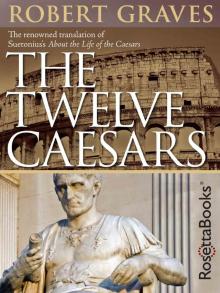 The Twelve Caesars
The Twelve Caesars Complete Poems 3 (Robert Graves Programme)
Complete Poems 3 (Robert Graves Programme) Homer's Daughter
Homer's Daughter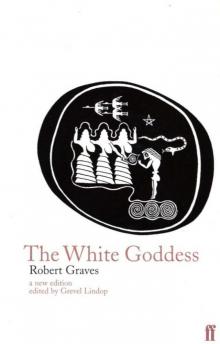 The White Goddess
The White Goddess Goodbye to All That
Goodbye to All That Claudius the God and His Wife Messalina
Claudius the God and His Wife Messalina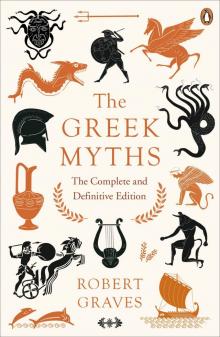 The Greek Myths
The Greek Myths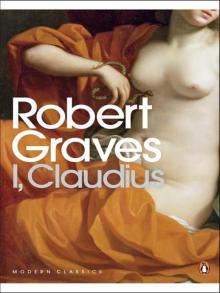 I, Claudius
I, Claudius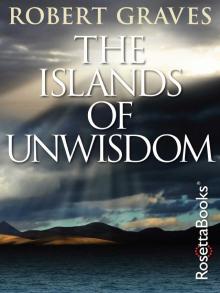 The Islands of Unwisdom
The Islands of Unwisdom Complete Short Stories
Complete Short Stories The Golden Fleece
The Golden Fleece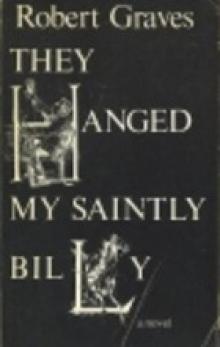 They Hanged My Saintly Billy
They Hanged My Saintly Billy King Jesus
King Jesus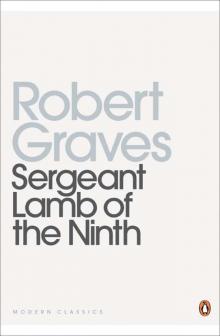 Sergeant Lamb's America
Sergeant Lamb's America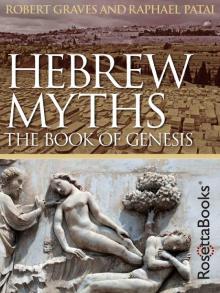 Hebrew Myths: The Book of Genesis
Hebrew Myths: The Book of Genesis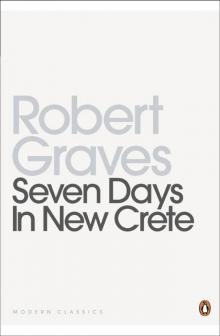 Seven Days in New Crete
Seven Days in New Crete Proceed, Sergeant Lamb
Proceed, Sergeant Lamb Claudius the God
Claudius the God Wife to Mr. Milton
Wife to Mr. Milton The Complete Poems
The Complete Poems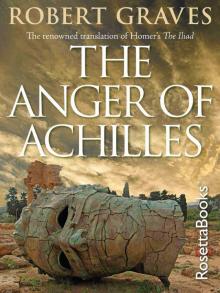 The Anger of Achilles
The Anger of Achilles Claudius the God c-2
Claudius the God c-2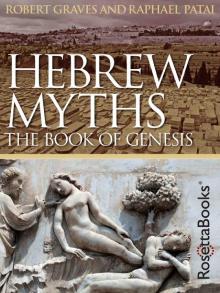 Hebrew Myths
Hebrew Myths I, Claudius c-1
I, Claudius c-1 The Greek Myths, Volume 1
The Greek Myths, Volume 1